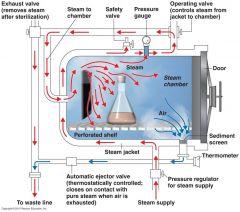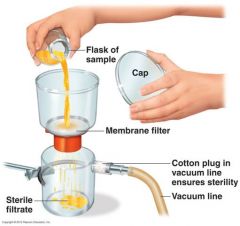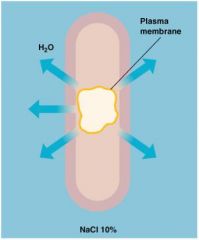![]()
![]()
![]()
Use LEFT and RIGHT arrow keys to navigate between flashcards;
Use UP and DOWN arrow keys to flip the card;
H to show hint;
A reads text to speech;
47 Cards in this Set
- Front
- Back
|
sepsis
|
pus forming infection
sepsis today refers to microbial contamination |
|
|
asepsis :
|
absence of significant contamination
|
|
|
aseptic surgery
|
techniques that prevent microbial contamination of wounds.
|
|
|
Sterilization:
|
Removal or killing of all microbial life
|
|
|
“commercial “ sterilization:
|
Killing Clostridium botulinum endospores
|
|
|
Disinfection:
|
Removal or killing of vegetative pathogens
|
|
|
Antisepsis:
|
Removal or killing of vegetative pathogens from living tissue
|
|
|
Degerming:
|
mechanical removal of microbes from a limited area
|
|
|
Sanitization:
|
Lower microbial counts on eating utensils to safe public health levels
|
|
|
Biocide/Germicide:
|
Kills microbes (bacteriocidal)
|
|
|
Effectiveness of antimicrobial treatment depends on:
|
Number of microbes
Time of exposure Microbial characteristics i.e. spore, gram + or gram -) Temperature (heat) autoclave 1210, boil 1000, etc.) Concentration (chemicals) Environment organic matter (proteins protect) temperature (warm or cool solutions) biofilms (chemicals difficult to penetrate) |
|
|
the most resistant bacterial structures
|
Spores
(prions most heat resistant among infectious agents) |
|
|
Autoclaving
|

Moist heat denatures proteins
Autoclave: Steam under pressure Kills all forms of life |
|
|
Boiling
|
Moist heat method
Kills all vegetative cells Some viruses Some spores resistant Disinfect drinking water |
|
|
Pasteurization
|
Classic and HTST is heat disinfection
reduces spoilage organisms and kills all milk-borne vegetative pathogens UHT method sterilizes milk Equivalent treatments Classic (holding method) 63°C for 30 min High-temperature short-time 72°C for 15 sec Ultra-high-temperature: 140°C for <1 sec |
|
|
Thermoduric
|
organisms that survive HTST pasteurization
Ex: Lactobacillus |
|
|
Dry Heat
|
Sterilization kills by oxidation
examples: Flaming : wire transfer loops Incineration: animals and infectious material discard Hot-air sterilization : glassware |
|
|
Filtration
|

Filtration removes microbes
Membrane filters : 0.45m diameter pores Heat sensitive media, serum, proteins, vitamins HEPA Filtration (high efficiency particulate air) Sterilize air Biological safety cabinets Operating and reverse isolation rooms |
|
|
Low Temperature
|
Preserves Bacterial Cultures
Low temperature inhibits microbial growth Examples: Refrigeration [0ºC to 8ºC] No frost freezer -10º to -20ºC Deep freezing [-20ºC to -80ºC] Liquid Nitrogen [-279ºC] Lyophilization : freeze drying frozen (-54° to -72°C) and dehydrated in a vacuum |
|
|
Desiccation
|
(drying) prevents metabolism
Mucous, pus, or feces confer resistance (protein protects) Spores ultra resistant Neisseria gonorrhoeae (easily killed) Mycobacterium tuberculosis (resistant) |
|
|
Osmotic pressure
|

causes plasmolysis
hypertonic environment high salt or sugar concentration resembles desiccation (water loss) Used in food preservation to cure meat or preserve fruit |
|
|
Non Ionizing Radiation [UV]
|
Ultraviolet light
Low penetrating power Thymine dimers Inhibits DNA replication Control microbes in air Sterilize vaccines, sera, and toxins Municipal waste and drinking water Eye damage and skin cancer |
|
|
Principles of effective disinfection
(Chemical) |
number microbes
time of exposure Gram + or Gram – concentration environment organic matter pH temperature |
|
|
chemicals
|
Few chemicals achieve sterility
-most reduce populations to safe levels -most remove or kill vegetative forms of pathogens |
|
|
Evaluating Disinfectants
|
TEST ORGANISMS : BACTERIOCIDAL:
Staphylococcus aureus (G+) Salmonella typhi (G-) Pseudomonas aeuroginosa highly resistant G- (Escherichia coli in lab) VIRUCIDAL: Newcastle Disease Virus (chicken embryos) |
|
|
Phenolic Compounds
|
1. Phenolics: (disinfectant)
O-phenylphenol (Lysol) 2. Bisphenols: (antiseptic) Hexachlorophene (pHisoHex) (Wash infants) Triclosan (soaps) 3.Biguanides (antiseptic) chlorhexidine Surgical scrub hand wash (4% in isopropyl alcohol) anti plaque, gingivitis (0.2%) |
|
|
Phenol coeffient
|
ratio of disinfecting power compared to Phenol
|
|
|
Lister
|
Father of Antiseptic Surgery (phenol)
|
|
|
Halogens (4)
|
1. Chlorine
2. Iodine (3.Bromine and 4. Fluorine are too toxic to work with) |
|
|
Chlorine
|
halogen, strong oxidizing agent
all G+, G-, many viruses and spores bleach (Clorox) is 5% hypochlorous acid (HOCl) 1/2 teaspoons in 2 gallons water disinfect clear water |
|
|
Iodine (antiseptic)
|
halogen;
more germicidal than chlorine all G+, G-, many viruses and spores tinture of iodine (iodide in ethyl alcohol) iodophore (iodine detergent complex) Preoperative skin preps Betadine, Wescodyne |
|
|
Burkholderia cepacia
|
Found embedded in interior surface of pipe in iodine manufacturing plant. Located after series of nosocomial (hospital) diseases traced to contaminated iodine.
|
|
|
Alcohols
|
Ethanol (70%)
Isopropanol (91%) Antiseptic and disinfectant Denature proteins, dissolve lipids 10 min exposure maximum effectiveness All bacteria and enveloped viruses ex. HIV, HSV, Influenza virus No effect non-enveloped viruses ex.poliovirus, hepatitis virus |
|
|
Heavy Metals
|
Oligodynamic action
tiny amount is anti microbial denature proteins 1% silver nitrate Mercuric chloride Mercurochrome and merthiolate Copper sulfate Zinc chloride |
|
|
Surface-Active Agents (Surfactants)
|
Decrease surface tension
Emulsification of lipids Amphiphatic property (mechanical removal) |
|
|
Soap
|
Degerming, little value antiseptic
|
|
|
Acid-anionic (—) detergents
|
Sanitizing mostly laundry detergents
|
|
|
Cationic (+) detergents
|
Bactericidal, Denature proteins, disrupt plasma membrane - strong germicides
|
|
|
Cationic detergents - QUATS
|
Antiseptic and disinfect inanimate objects
NH4+ (quaternary ammonium compound) Strongly bacteriocidal verses G+ and enveloped viruses Ineffective spores and tuberculosis bacteria Cepacol [cetylpyridinium chloride] Zephiran [ benzalkonium chloride mouthwash antisepsis of skin and mucous membranes and as a disinfectant in surgery) disinfectant for hospital utensils and other environmental surfaces, thermometers, metal instruments and catheters. |
|
|
Chemical Food Preservatives
|
Organic Acids, Salts, and Antibiotics
Inhibit metabolism Sorbic acid (cheese), benzoic acid (soft drinks), calcium propionate (bread) Control molds and bacteria in foods and cosmetics Nitrite (ham, bacon, hot dogs, sausage) prevents endospore germination Antibiotics. Nisin and natamycin prevent spoilage of cheese |
|
|
Alkylating agents
|
Chemical Sterilization
Glutaraldehyde and Formaldehyde (liquids) Ethylene oxide (gas) inactivate proteins by cross-linking with functional groups (–NH2, –OH, –COOH, —SH) sporicidal but usually not considered practical sterilants |
|
|
Ethylene Oxide
|
Gaseous Chemosterilizer
frequently used as substitute for physical sterilization All microbes and endospores killed explosive Mix with CO2 or N2 4-18h exposure remarkable penetrating power with no heat electrical gear on spacecraft, medical supplies and instruments Ex. Pillows, mattresses, bedding |
|
|
Peroxygens
|
Oxidizing agents
Hydrogen peroxide H2O2 6% sterilize bone implants 6h exposure required Benzoyl peroxide (acne medication) |
|
|
Resistant Chart
|

|
|
|
Enveloped viruses
|
(human immunodeficiency virus, influenza virus, herpes simplex virus) are susceptible to almost all chemicals.
|
|
|
Non enveloped viruses (hepatitis virus, poliovirus) are relatively resistant to chemicals (aldehydes, alcohol, QUATS, halogens, and phenolics have poor to fair activity).
|
(hepatitis virus, poliovirus) are relatively resistant to chemicals (aldehydes, alcohol, QUATS, halogens, and phenolics have poor to fair activity).
|
|
|
G+versus G-.
|
G+ more susceptible than G- to chemical but more resistant to heat.
|

